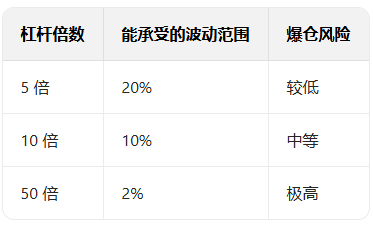1. Using too much leverage, a fluctuation can "wipe you out".
Common mistakes made by newbies: always thinking about "making enough in one go", opening 50x or 100x leverage during full investment. However, the cryptocurrency market is already highly volatile; if the market reverses by 1%-2%, high leverage cannot withstand it, leading directly to liquidation.
Data shows:

Risk of liquidation based on leverage multiples: 5 times - 20% low, 10 times - 10% moderate, 50 times - 2% extremely high.
💡 Newbie advice: Start with 3-5 times leverage to practice; preserving capital allows for future opportunities!
2. Not using stop-losses, stubbornly holding on, leading to losses becoming a "bottomless pit".
Typical mindset:
"Just wait a bit, it will definitely bounce back" → As a result, the market continues to drop until liquidation without a turnaround.
"I've already lost 50%, selling would be too much of a loss" → In the end, watch helplessly as losses reach 100%.
💡 Correct operation:
Set a stop-loss as soon as you open a position (for example, 3%-5%), drawing a line for risk in advance.
Slowly raise the stop-loss point after making a profit, "locking in" the profits earned.
3. Fully invested, a single mistake means going to zero.
The most common risks that newbies love to take:
"This opportunity is rare, I'm investing everything!" → When the market reverses, liquidation happens without discussion.
"I'm betting this one time, if I win, I'll stop" → Often, this is the prelude to losing everything and leaving.
Position management can be calculated as follows:
Maximum position per trade = Capital × 2% ÷ Leverage multiple.
(For example: $10,000 capital, using 10x leverage, the maximum per trade is $200.)
💡 Key principles:
Do not open positions exceeding 5% of total capital each time.
Diversify trading; don't let a single trade determine life or death.
4. Being led by emotions, chasing highs and lows becomes the norm.
Common operational pitfalls:
Seeing others making money, fearing to miss the opportunity, jumping in at high positions to "pick up the tab."
Panic during a market crash, selling at a low price, only to see the market rebound right after selling.
Data shows: 80% of liquidations occur during periods of severe market volatility. Often, it's not the market that is too harsh, but emotions that distort operations.
💡 Solution:
Prepare a trading plan in advance: how much to buy, how much to sell, where to set stop-loss, and strictly follow the plan.
Don't stay up late staring at the market; fatigue and tension will only amplify emotional interference.
5. Not understanding the platform's "hidden traps", leading to "unexpected" liquidations.
Be wary of some trading platforms' tricks:
"Spike": A sudden drop or surge in price that triggers a large number of stop-loss orders, followed by a quick recovery, often catching many newbies off guard.
Slippage: In extreme market conditions, the actual execution price can differ significantly from your set price, resulting in substantial losses as soon as the order is executed.
💡 Pitfall-avoidance techniques:
Prioritize choosing mainstream exchanges with a good reputation; the rules are relatively transparent.
Avoid trading during extreme market conditions, such as when the Federal Reserve announces policies or during concentrated large liquidations; the risk is too high.
Ultimately, contract trading itself carries high risks. Newbies shouldn't think about "getting rich quickly"; first, grasp the basic rules and risk control to preserve capital, allowing you to stay in the market longer.
